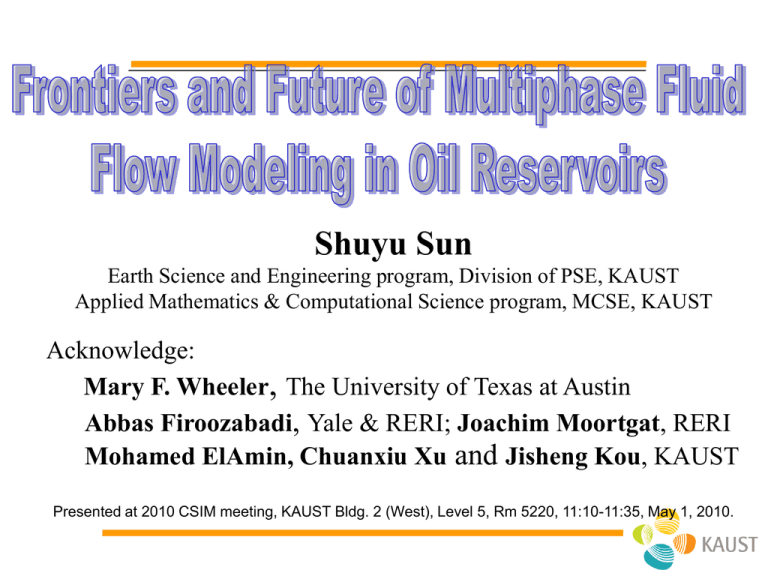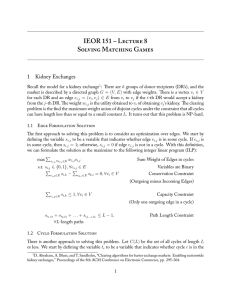PPT
advertisement

Shuyu Sun
Earth Science and Engineering program, Division of PSE, KAUST
Applied Mathematics & Computational Science program, MCSE, KAUST
Acknowledge:
Mary F. Wheeler, The University of Texas at Austin
Abbas Firoozabadi, Yale & RERI; Joachim Moortgat, RERI
Mohamed ElAmin, Chuanxiu Xu and Jisheng Kou, KAUST
Presented at 2010 CSIM meeting, KAUST Bldg. 2 (West), Level 5, Rm 5220, 11:10-11:35, May 1, 2010.
Energy and Environment Problems
Single-Phase Flow in Porous Media
• Continuity equation – from mass conservation:
t
u q m
• Volumetric/phase behaviors – from
thermodynamic modeling:
(T , P ) ( P )
• Constitutive equation – Darcy’s law:
u
K
p
Incompressible Single Phase Flow
• Continuity equation
u
q
(
x
,
t
)
(
0
,
T
]
• Darcy’s law
K
u
p
(
x
,
t
)
(
0
,
T
]
• Boundary conditions:
p pB
( x , t ) D (0,T ]
u n uB
( x , t ) N (0,T ]
DG scheme applied to flow equation
• Bilinear form
K
K
K
a
(
p
,)
p
{
p
n
}
[
]
s
{
n
}
[
p
]
K
K
[
p
n
s
n
p
p
]
[
]
1
h
s
1
E
E
T
h
e
e
e
E
h
f
o
r
m
e
e
E
h
e
e
e
e
D
e
f
o
r
m
e
e
D
e
e
E
he
e
form
• Linear functional
0
0
0
0
K
l
(
)
(
q
,)
s
n
p
u
form
e
B
B
e
e
D
• Scheme: seek
SIPG
OBB-DG, NIPG
IIPG
OBB-DG
NIPG
SIPG,IIPG
e
e
N
p
D
(
T
)
h
k h such
that
a
(
p
,
v
)
l
(
v
)
v
D
(
T
)
h
k
h
Transport in Porous Media
• Transport equation
c
*
u
c
D
(
u
)
c
qc
r
(
c
) (
x
,
t
)
(
0
,
T
]
t
• Boundary conditions
uc D c n c B u n
t (0,T ], x in (t )
D c n 0
• Initial condition
c
(
x
,
0
)
c
(
x
)
0
t (0,T ], x out ( t)
x
• Dispersion/diffusion tensor
D
(
u
)
D
I
u
E
(
u
)
I
E
(
u
)
ml
t
DG scheme applied to transport equation
• Bilinear form
c
u
n
[
]
c
u
n
cq
[
c
][
]
h
B
(
c
,;
u
)
D
(
u
)
c
c
u
{
D
(
u
)
c
n
}[
]
s
{
D
(
u
)
n
}[
c
]
e
form
e
E
E
T
h
e
e
E
h
e
e
E
h
*
e
e
E
h
e
e
e
E
h
,
out
e
e
e
e
E
e
h
• Linear functional
L
(
;
u
,
c
)
c
q
c
u
n
r
(
M
(
c
))
• Scheme: seek c
(
,
t
)
D
(
T
) s.t.
h
r h
I.C. and
w
B
e
e
e
E
h
,
in
c
(
h,
)
B
(
c
,
;
M
(
u
))
L
(
;
M
(
u
))
h
h
h
t
D
(
T
)
t
(
0
,
T
]
r h
Example: importance of local conservation
Example: Comparison of DG and FVM
Upwind-FVM on 40 elements
Linear DG on 20 elements
Advection of an injected species from the left boundary under
constant Darcy velocity. Plots show concentration profile at 0.5 PVI.
Example: Comparison of DG and FVM
FVM
Linear DG
Advection of an injected species from the left. Plots
show concentration profiles at 3 years (0.6 PVI).
Example: flow/transport in fractured media
Locally refined mesh:
FEM and FVM are better than FD
for adaptive meshes and complex geometry
Example: flow/transport in fractured media
L2(L2) Error Estimators
Adaptive DG example
A posteriori error estimate
in the energy norm for all primal DGs
1
/
2
2
C
c
D
(
u
)
C
c
K
E
2
2
2
L
(
L
)
L
(
L
)
E
Ε
h
DG
1
/
2
DG
h R
h
I L(L(E
R
B
1 L(L())
))
2
E
2
E
2
2
2
2
2
2
E
1
2
1
1
2
h
R
2 2
2 2
R
B
1L
B
0L
(L())
(L())
2
2
h
E
E
1
2
1
2
h
h
R
/
t L2(L2())
2
R
B
0L
B
0
(L())
2
2
E
E
Proof Sketch: Relation of DG and CG spaces
through jump terms
S. Sun and M. F. Wheeler, Journal of Scientific Computing, 22(1), 501-530, 2005.
Anisotropic mesh adaptation
Adaptive DG example (cont.)
L2(L2) Error Estimators on 3D
Adaptive DG example in 3D
T=1.5
T=2.0
T=0.1
T=0.5
T=1.0
Two-Phase Flow Governing Equations
• Mass Conservation
(p
S
)
p
u
0
,
p
p
t
p
n
,
w
• Darcy’s Law
k
rp
u
K
P
g
D
,
p
n
,
w
p
p p
p
• Capillary Pressure
P
P
P
P
(
S
)
c n w cw
• Saturation Summation Constraint
S
S
1
w
n
DG-MFEM IMPES Algorithm – Pressure Equ
• If incompressible (otherwise treating it with a source term):
S
p
u
0
,
p
t
u
0
t
p
n
,
w
• Total Velocity:
k
rp
,
u
u
u
K
K
w
n
t a
c t
w
n c
p t
p
P
g
D
,p
n
,
w
ppp
• Pressure Equation:
i
1
i
1
K
u
K
t
w a
n c
i
i
i
• MFEM Scheme:
– Apply MFEM
– Two unknown variables: Velocity Ua and Water potential
DG-MFEM IMPES Algorithm – Saturation Equ
• Solve for the wetting (water) phase equation:
S
w
u
0
w
t
• Relate water phase velocity with total velocity:
u
fw
u
wu
w
a
a
t
• Saturation Equation (if using Forward Euler):
S
fu
S
i
1
i w
t
i i
w
a
i
i w
t
• DG Scheme:
– Apply DG (integrating by parts and using upwind on element
interfaces) to the convection term.
Reservoir Description (cont.)
• Relative permeabilities (assuming zero residual
saturations):
m
m
k rw S we , k rn 1 S we , S we S w , m 2
• Capillary pressure
p c ( S we ) B c log S we , S we S w , B c 5 and 50 bars
K=100md
K=1md
Comparison: if ignore capillary pressure …
With nonzero
capPres
With zero capPres
Saturation at 10 years: Iter-DG-MFE
Saturation at 3 years
Notice that Sw is continuous within each rock,
but Sw is discontinuous across the two rocks
Iter-DG-MFE Simulation
Saturation at 5 years
Notice that Sw is continuous within each rock,
but Sw is discontinuous across the two rocks
Iter-DG-MFE Simulation
Saturation at 10 years
Notice that Sw is continuous within each rock,
but Sw is discontinuous across the two rocks
Iter-DG-MFE Simulation
Compositional Three-Phase Flow
• Mass Conservation (without molecular diffusion)
Ui
c x
i ,
u
w ,o , g
• Darcy’s Law
u
k r
K P g ,
28
w, o, g
Example of CO2 injection
• Initial Conditions: C10+H2O(Sw=Swc=0.1), 100 bar,160 F.
• Inject water (0.1 PV/year) to 2 PV, then inject CO2 to 8
PV. Poutlet= 100 bar
• Relative permeabilities:
– Quadratic forms except nw=3.
– Residual/critical saturations:
• Sor = 0.40; Swc = 0.10; Sgc = 0.02
• Sgmax = 0.8; Somin = 0.2
0
0
• k 0 0 . 3 ; k rg0 0 . 3 ; k row
; k rog
0 .3
0
.
3
rw
29
Example (cont.)
MFE-dG 0.1 PVI.
MFE-dG 0.2 PVI.
30
MFE-dG 0.5 PVI.
Example 3 (cont.)
nC10 at 10% PVI CO2
nC10 at 200% PVI CO2
Remarks for Multiphase Flow
• Framework has been established for
advancing dG-MFE scheme for three-phase
compositional modeling. In our formulation
we adopt the total volume flux approach for
the MFE.
• dG has small numerical diffusion
• CO2 injection
– Swelling effect and vaporization
– Reduction of viscosity in oil phase
– Recovery by CO2 injection > Recovery by
C1 > Recovery by N2
32
EOS Modeling of Phase Behaviors
• PVT modeling: EOS
– Peng-Robinson EOS
– Cubic-plus-association EOS
• Thermodynamic theory
• Stability calculation
– Tangent Phase Distance (TPD) analysis
– Gibbs Free Energy Surface analysis
• Flash calculation
– Bisection method (Rachford-Rice equation)
– Successive Substitution
– Newton’s method
Gibbs Ensemble Monte Carlo simulation
E E
I
I
N ,V
E
I
I
N ,V
E
I
II
I
I
E E
II
II
N ,V
II
II
II
N ,V
II
E E
E E
I
II
I
II
N ,V V N ,V V
I
II
I
E E
I
N 1,V
I
II
I
E E
I
N 1,V
II
II
II
II
Three Monte Carlo movements in simulation
Particle displacements
Volume Change
Particle Transfer
Microstructure from the ab initio calculation
The microstructure of the molecular models form the ab initio calculation
Bond length(Å)
OH(H2O)
OH(H2O) 2
CH(C2H6)
CH(H2O----C2H6)
(H2O)
H
O
H
H
O
H
(H2O) 2
Angle(degree)
0.9619
0.9698
1.0938
1.0940
H
C
H
T-shaped pair of water
molecules
Hydrogen length(Å)
1.9321
105.06
105.28
107.5
The nearest neighbor
interaction between
the Water and Ethane
Water-ethane high pressure equilibria at T=523 K
Experimental data are from Chemie-Ing. Techn. (1967), 39, 816
EoS: Statistical-Associating-Fluid-Theory (SAFT)











